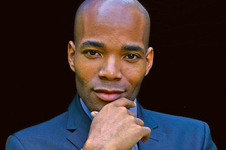This concert was booked as “An exquisite homage to the afterlife, … music by 20th Century composers offer(ing) glimpses of passage from life to death.” It was titled “Beginning to See the Light,” assumed to be a reference to the Ellington/George/Hodges/James jazz standard made popular by Ella Fitzgerald, Kitty Kallen, Harry James and the like in the late 1940s.
Cantari is the audition-select elite chorus from Voices (nee Chapel Hill Community Chorus) and is directed by Dr. Sue T. Klausmeyer, widely known for her numerous and outstanding contributions in the field of choral conducting. Guest organist Matthew Brown is the Director of the Stanback Department of Sacred Music and organist at First United Methodist Church in Salisbury, NC. His preparation includes degrees from the North Carolina School of the Arts and the Eastman School of Music.
The featured work on the program was Maurice Duruflé‘s supremely serene Requiem, Op. 9, composed in 1947 on commission from the French music publisher Durand. It is thoroughly infused with Gregorian chant which was a favorite area of inspiration for Duruflé. There are three arrangements of the work: one for organ alone, one for organ with string orchestra and optional trumpets, harp and timpani, and one for organ and full orchestra. On this occasion we heard the superbly crafted organ setting.
The work opens with a flowing organ accompaniment over which the men enter singing in unison to be later joined by the women with a wordless counter melody. Especially in such a gracious setting as Chapel of the Cross and with the excellent singing of Cantari, the music carried one off to a different world; ethereal, serene and uplifting.
Though the Dies Irae is omitted from Duruflé‘s setting, elements of it are touched on in the “Domine Jesu Christe,” but nothing like the terrifying treatment of Berlioz or Verdi. The majestic Sanctus was a highlight of the performance. The best-known section of the piece, “Pie Jesu,” was sung by the sopranos in unison as Duruflé seemed to prefer it. The Agnus Dei has the chant in the chorus with a counter melody played by the organ. The baritone solo of the “Libera me” was sung by the entire baritone section. The rich harmonies and beautiful chant melody of “In Paradisum” ended the piece with a calm sense of restfulness.
Cantari provided inspired singing and organist, Matthew Brown, delivered a masterful performance.
Next on the program was a special treat; Duruflé‘s “Chorale varié sur le thème du ‘Veni Creator,'” Op. 4. The men of the chorus sang with precision and first rate intonation the verses of the hymn, while Brown gave a virtuoso performance of Duruflé‘s inventive variations. Especially impressive was the last variation, a brilliant toccata reaching a stirring climax, which earned Brown a standing ovation.
The three closing pieces followed without intermission. First there was a setting of one of the movements of the Requiem; “In Paradisum” by the highly regarded American composer, Edwin Fissinger (1920-1990). This was followed up with “Sleep” by the very popular choral composer, Eric Whitacre. This is the second – now three and a fourth in the works – of Whitacre’s on-line Virtual Choir phenomenon. If you are not familiar with this, you are encouraged to look up Eric Whitacre on YouTube. Closing the program was Edgar Bainton’s superb anthem “And I Saw a New Heaven” based on Revelation 21:1-4. Especially lovely is the line “And God shall wipe away all tears,” in the tenor part.
Cantari sang with first-rate class and left the audience with warm feelings and a sense of quiet reverence. Klausmeyer leads with confident and stable direction. The result is a treasure for those who love the choral art.











